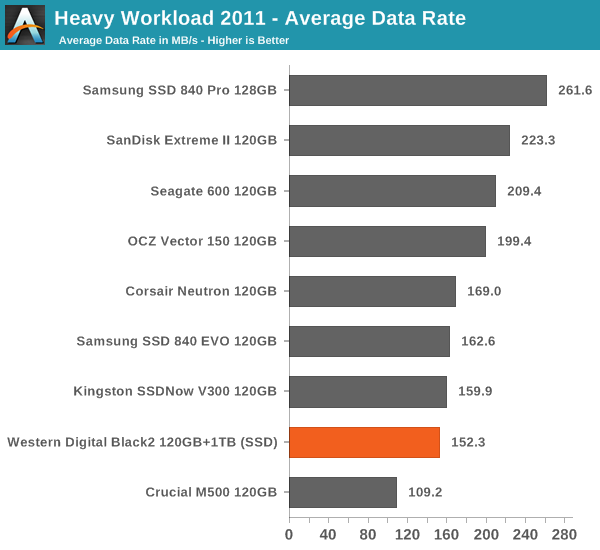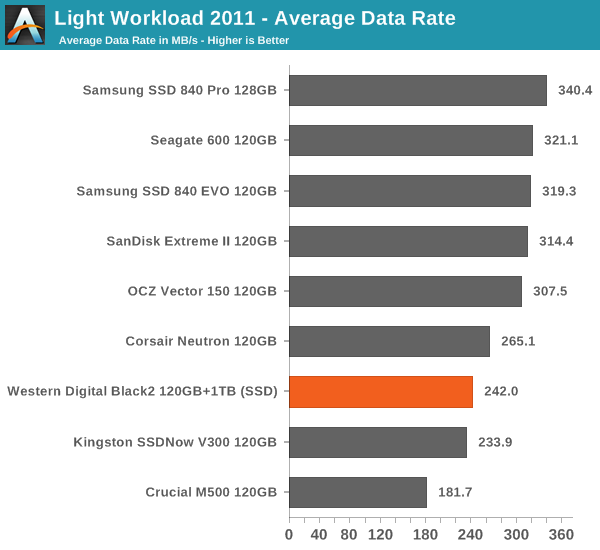The WD Black2 Review: World's First 2.5" Dual-Drive
by Kristian Vättö on January 30, 2014 7:00 AM ESTAnandTech Storage Bench 2011
Two years ago we introduced our AnandTech Storage Bench, a suite of benchmarks that took traces of real OS/application usage and played them back in a repeatable manner. The MOASB, officially called AnandTech Storage Bench 2011 - Heavy Workload, mainly focuses on peak IO performance and basic garbage collection routines. There is a lot of downloading and application installing that happens during the course of this test. Our thinking was that it's during application installs, file copies, downloading and multitasking with all of this that you can really notice performance differences between drives.
We tried to cover as many bases as possible with the software incorporated into this test. There's a lot of photo editing in Photoshop, HTML editing in Dreamweaver, web browsing, game playing/level loading (Starcraft II & WoW are both a part of the test) as well as general use stuff (application installing, virus scanning). We've included a large amount of email downloading, document creation and editing as well. To top it all off we even use Visual Studio 2008 to build Chromium during the test.
The test has 2,168,893 read operations and 1,783,447 write operations. The IO breakdown is as follows:
| AnandTech Storage Bench 2011 - Heavy Workload IO Breakdown | ||||
| IO Size | % of Total | |||
| 4KB | 28% | |||
| 16KB | 10% | |||
| 32KB | 10% | |||
| 64KB | 4% | |||
Only 42% of all operations are sequential, the rest range from pseudo to fully random (with most falling in the pseudo-random category). Average queue depth is 4.625 IOs, with 59% of operations taking place in an IO queue of 1. The full description of the test can be found here.
AnandTech Storage Bench 2011 - Heavy Workload

AnandTech Storage Bench 2011 - Light Workload
Our light workload actually has more write operations than read operations. The split is as follows: 372,630 reads and 459,709 writes. The relatively close read/write ratio does better mimic a typical light workload (although even lighter workloads would be far more read centric). There's lots of web browsing, photo editing (but with a greater focus on photo consumption), video playback as well as some application installs and gaming.
The I/O breakdown is similar to the heavy workload at small IOs, however you'll notice that there are far fewer large IO transfers.
| AnandTech Storage Bench 2011 - Light Workload IO Breakdown | ||||
| IO Size | % of Total | |||
| 4KB | 27% | |||
| 16KB | 8% | |||
| 32KB | 6% | |||
| 64KB | 5% | |||











100 Comments
View All Comments
chizow - Friday, January 31, 2014 - link
Hmm yeah you're right, I didn't know this was priced so high at $290 and 1TB SSDs are in that $500-600 range now from what I've seen.This would probably need to drop down to ~$180 to be worthwhile, based on pricing of a 120SSD ($80ish) and 1TB 2.5" HDD ($80) with a small premium for combined slot.
Braumin - Thursday, January 30, 2014 - link
This is a bit silly. If they had gone to the trouble of merging the two into a single logical unit, it would make more sense.As you rightly pointed out - it makes little sense to anyone. If you need more space, you can do that in so many other ways...
This needed to be like the Fusion drive or it's DOA.
Mayuyu - Thursday, January 30, 2014 - link
Dead on Arrival. Device makers don't believe that consumers can handle a file manager. WD thinks people want to separate their files between a hard drive and a SSD?mikato - Friday, January 31, 2014 - link
I'm not giving it to my parents, that's for sure. They only get single drive systems. It may be an SSD if they keep dropping in price.speculatrix - Thursday, January 30, 2014 - link
Am I the only person who on seeing the picture of someone holding the nSATA card by its connector thinks "well, that's part ruined... likely to die early from ESD, or corrosion on the edge connector"?Gigaplex - Thursday, January 30, 2014 - link
The devices held like that for marketing purposes are often defective parts already.Gasaraki88 - Thursday, January 30, 2014 - link
I'm not seeing the point of this drive. Why don't I get a 128SSD and a 1TB drive separately?Gasaraki88 - Thursday, January 30, 2014 - link
They should have made this a hybrid drive. That would have been awesome, 128GB SSD cache with a 1TB spinning disk.kmmatney - Monday, February 3, 2014 - link
The Seagate Momentus XTs are already pretty nice with an 8 GB cache (I have 2 of the older models with 4GB cache, and even those are "pretty good"). So a hybrid with this much cache could be awesome. I don't think the hybrid drives cache writes, so that would limit performance. I'm on the fence with this - I think it needs to be priced around $200 to be more interesting.mr_tawan - Thursday, January 30, 2014 - link
Some people on a laptop does only have 1 bay for 2.5" drive available, with no mSATA socket whatsoever. Given that larger SSD is still quite expensive, you might have to choose between having a speedy system with no room for storage, and a plenty of space but slow as snail.These people might go with SSD and a USB3 HDD, of course, but carrying another external drive makes the system bit less mobile.
If the laptop has optical drive, then you might swap it with a 2.5" drive caddy. But it does not, well this might be a good option.
Too bad the drive does not really perform, and it's pretty pricey. I'd have gone with a drive caddy and a external bluray drive :-(.